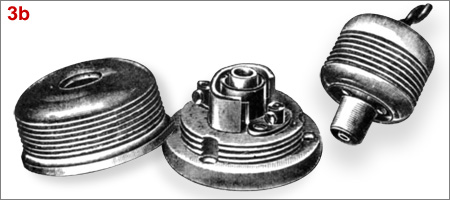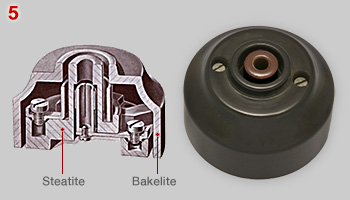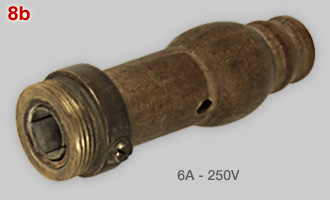 |
Concentric plugs and sockets |
page |
special plugs |
| Electricity
in homes was initially restricted to illumination. Other domestic
applications of electricity followed soon and
necessitated development of wall sockets and matching plugs. The first
two-pin plugs were designed in the mid 1880s. Concentric plugs
appeared a couple of years thereafter. Two types of concentric sockets and plugs have been designed: (1) plugs with a central pin and concentric ring contact (see image 1); variants existed (see image 3); (2) plugs that have a single pin with two contacts in succession (see image 2). Concentric plugs are always polarized, in contrast to nearly all 2-pin plugs; a plus. Nevertheless their use has been restricted largely to special applications in which irreversibility matters (among other direct current), or voltage different from the standard domestic voltage. A disadvantage of single pin concentric plugs is their large size. Concentric plugs are rarely used anymore, except small jack plugs for ultra-low voltage and audio connections. |
 |
 |
1 Plug with a central pin and a concentric ring contact. Typical dimensions are: 5 - 6 mm pin diameter and 8 - 9 mm spacing between pin and ring. Matching socket is shown in image no. 7. 2 Single pin plug. Typical contact diameters are 6 and 13 - 16 mm. Matching socket is shown in image no. 11. Sngle pin plug design could have be based on jack plugs, used from late 1870s as telephone switch board connectors. |
 |
 |
 |
 |
| 3a, b |
Concentric
plugs and sockets that are based on a design by
Gustav Binswanger, electrical engineer in London and founder of
British General Electric Company (G.E.C.). Images 3a and 3b show two
variants that date back to late 1890s - early 1900s; 3a is possibly a
bit older design than 3b. Both variants were rated at 5A-250V. Both have a large outer, ring shaped contact, but the central contact differs. 3a: socket has a central pin; consequently the plug must have a hollow contact (comparable to plug 3b). 3b: both socket and plug have ring shaped contacts. |
| 3c | Binswanger's
patent application for "An
improved Wall Socket and Plug for Electric Lighting and kindred
Purposes" (British patent No. 16,898) dates back to June 10, 1985 and
was accepted August 1, 1986. Image 3c shows patent fig. 6*. Socket and plug have contact types similar to images 3d, 4-6 (Siemens) and 7 (Berger). * redrawn and coloured to enhance visibility of structural elements. |
| 3d | Image
shows a ca. 1910 design that was
adopted by the British Admiralty. GEC has made a specially adapted version for marine use. The socket had a gun-metal case, a separate cover for use when the plug has been removed and a lead scaling gland for lead-covered cables. Both versions were rated at 5A-250V. Image sources: 3a: Electric Light Installations by David Salomonson, Volume II. Apparatus. 7th edition, 1894. Figure 174 (page 235). 3b: GEC 1904 catalog, page 423, catalog No. S 6638; also mentioned 1934 catalog, but no longer in the 1951 catalog. 3c: Patent GB189516898(A), see Espacenet link. 3d: GEC 1911 catalog, page 796; the marine version S 697 is shown on page 798. |
 |
 |
 |
| 4 - 6 |
Concentric
socket and plug made by Siemens - Schuckertwerke in Berlin. Production
started second half of 1920s and lasted until first half of 1950s.
Rating: 10A - 250V. Schemes of socket and plug cross sections have been
copied fro a 1938 Siemens catalog. The socket cross section shows an
adequate steatite insulation between inner and contact ring. Image 4
shows that the insulation top part is replaced by a brownish Bakelite
collar. The Siemens catalog emphasizes the impossibility to exchange poles, a self-evident issue for DC battery chargers, but also important for laboratory equipment and for safe use of portable tools outdoors. {RH} |
 |
7 Concentric socket and plug, made by Walter Berger Electromechanische Ausrüstungen GmbH in Beeliz (Brandenburg, Germany). Rating: 10A - 42V*. Plug is not compatible with Siemens socket (no. 5), because Berger plug pin has a larger diameter (6.0 versus 5.0 mm). Outer rings have a comparable diameter (16.1 versus 16.0 mm). * Low, "not dangerous" voltage local circuits were used in the German Democratic Republic (DDR), among others in wet rooms and at schools, hospitals and laboratories. Using concentric plugs avoid the risk of connecting 42V appliances to 220V. Production of 42V devices ended soon after the reunification of eastern and western parts of Germany. PM
(socket), WN (plug)
|
 |
 |
 |
 |
| 8a | Plugs
with two concentric contacts and housing made of Lignum vitae
wood.
Concentric plugs have been made in Germany from early 1900s until mid
1960s, mainly for more demanding (outdoor )use. In Germany they were known as Garagenstecker or Zentralstecker. Shown examples and images in
catalogs show they were often
equipped with a watertight locking
sleeve.
Occasionally they were also offered for domestic use (see no. 9). Versions existed that were rated at 4, 6, 10, 15 and 20 A. Wooden and ebonite plugs have been made until late 1920s. {WN} |
| 8b | Concentric
6A
connector, matching with the 6A plug shown in image 8b. {WN} None of the wooden concentric plugs and connector have a name or logo of the manufacturer(s). |
| 9a, b |
Concentric
plug with black glazed
porcelain outlet
found
at the attic of a 100+ years old stately home in Rotterdam,
Netherlands. Plug and pin dimensions are similar to plug no. 5 (top
model). The brass ring to secure the plug indicates a 4 Amp 250 Volt
rating. The outlet has contacts with a diameter of 5.3 mm (left) and 4.1 mm (right). Matching plugs were, among others, made by Stotz-Kontakt (see order no. 14353). It seems likely that this combination of plug and outlet was designed for a special purpose; similar devices have not been found in catalogs. Manufacturer is unknown. {YG & FS} |
 |
10 General Electric Company 1951 catalog shows on page 235 ship's type connectors. Nos S 899B and S 899A are respectively a single pin concentric cargo socket and plug. The plug has a long Lignum vitae wood handle and resembles the old wooden plugs shown in image 8a. Rating is not given. Given the same target group it seems likely that rating is comparable to the WISKA socket and plug; see images 12-15. |
 |
 |
| 11a, b | Splash
water resistant, concentric plug, rated at 10A - 250V. The housing has
been made of a
thermosetting urea-formaldehyde resin reinforced with cellulose. Image
11b shows the plug inside, made of copper and steatite. Manufacturer: Maehler & Kaege in Ingelheim am Rhein. Dating: 1950s. {WN} |
 |
 |
 |
 |
 |
| Images 12 - 15 show a modern version of a
classic type concentric socket and plug that is still used for marine
applications. Material shown, made by WISKA
(Kaltenkirchen, Germany), has been delivered by the Dutch WISKA
representative Rometel
Trade B.V. |
|
| 12, 13 |
Concentric, polyamide, surface mount
socket, rated at
10A - 50V. Image no. 10 shows the IP 56 watertight socket with closed
screw cap; images no. 11 shows the concentric contacts. |
| 14, 15 |
Socket and matching 10A - 50V, IP 56 plug.
Pin and contact sizes are identical to 6A - 250V wooden plug shown in
image 8a. |
| 16 | Despite ca. 100 years difference in age,
the WISKA plug fits perfectly in a wooden 6A - 250V connector (image
8b). Even
dimensions and screw thread of the brass locking collar have not been
changed. |
| |
D i g i t a l M u s e u m o f | |
P l u g s a n d S o c k e t s | |